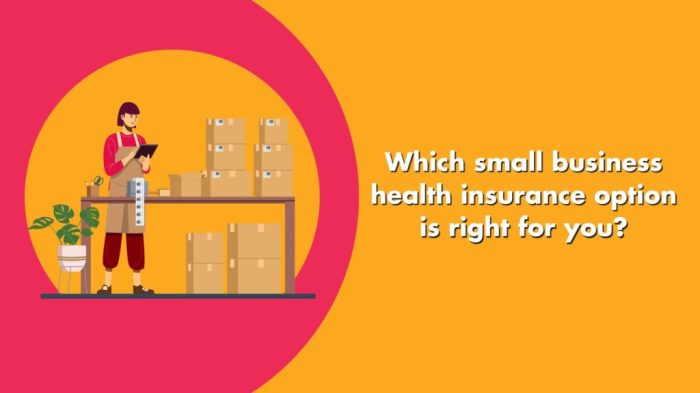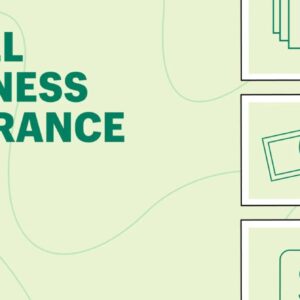Insurance options for small business owners are crucial, but navigating the world of policies, premiums, and coverage can feel like scaling Mount Everest in flip-flops. From general liability to workers’ compensation, the choices are vast and the jargon dense. This guide cuts through the confusion, offering a practical roadmap to help you find the right insurance protection for your business without breaking the bank or your brain.
We’ll explore the different types of insurance small businesses need, the factors that impact costs, and how to find the best providers. We’ll also tackle common coverage gaps and offer savvy strategies for managing your insurance expenses. By the end, you’ll be equipped to make informed decisions, securing your business against unforeseen risks and focusing on what matters most: growth.
Types of Insurance
Navigating the world of small business insurance can feel like wading through a swamp of jargon. But understanding the different types of coverage is crucial for protecting your hard-earned investment and ensuring peace of mind. Choosing the right insurance isn’t just about ticking boxes; it’s about building a safety net tailored to your specific business needs. Let’s break down some key types.
General Liability Insurance, Insurance options for small business owners
General liability insurance protects your business from financial losses due to accidents, injuries, or property damage that occur on your premises or as a result of your business operations. Imagine a customer slips and falls in your store – general liability insurance would cover medical expenses and potential lawsuits. It’s a foundational policy for most small businesses, providing a buffer against unforeseen incidents. This coverage typically includes bodily injury liability, property damage liability, and personal and advertising injury liability. The cost varies based on factors like your business type, location, and number of employees. A small bakery might pay significantly less than a construction company.
Professional Liability Insurance (Errors and Omissions Insurance)
This insurance, often called Errors and Omissions (E&O) insurance, protects professionals from claims of negligence or mistakes in their services. For example, a consultant who gives faulty advice could face a lawsuit; E&O insurance would help cover legal fees and settlements. This is particularly crucial for businesses offering professional services like consulting, design, or accounting. The cost depends on factors such as the type of profession, the potential for liability, and the size of the business. A freelance graphic designer will likely have a different premium than a large architectural firm.
Property Insurance
Property insurance protects your physical assets, including your building, equipment, inventory, and even business personal property. This coverage safeguards your business from financial ruin in the event of fire, theft, vandalism, or natural disasters. Imagine a devastating fire destroying your restaurant’s kitchen equipment – property insurance helps you rebuild and replace those crucial assets. The cost is influenced by factors such as the location of your business, the value of your assets, and the type of building you occupy. A business in a high-risk area will naturally pay more.
Workers’ Compensation Insurance
If you have employees, workers’ compensation insurance is a legal requirement in most jurisdictions. This insurance covers medical expenses and lost wages for employees injured on the job. It protects your business from costly lawsuits and ensures your employees receive the care they need. The cost depends on the risk associated with your industry, the number of employees, and the claims history of your business. A construction company will likely have higher premiums than a retail store.
Commercial Auto Insurance
If your business uses vehicles for deliveries, sales calls, or other operations, commercial auto insurance is essential. It covers accidents, injuries, and property damage caused by your company vehicles. This insurance is distinct from personal auto insurance and offers broader coverage for business-related use. The cost factors are similar to personal auto insurance, such as the type of vehicle, driving record, and location. A company with a fleet of delivery trucks will pay significantly more than a business using a single car.
| Insurance Type | Coverage Summary | Typical Cost Factors | Benefits for Small Businesses |
|---|---|---|---|
| General Liability | Bodily injury, property damage, personal & advertising injury | Business type, location, employees | Protection against lawsuits & accidents |
| Professional Liability (E&O) | Negligence or mistakes in professional services | Profession type, liability potential, business size | Protection against claims of faulty services |
| Property Insurance | Building, equipment, inventory, business personal property | Location, asset value, building type | Protection against fire, theft, & natural disasters |
| Workers’ Compensation | Medical expenses & lost wages for injured employees | Industry risk, number of employees, claims history | Compliance with law, employee protection, avoids costly lawsuits |
| Commercial Auto | Accidents, injuries, & property damage from business vehicles | Vehicle type, driving record, location | Protection against accidents involving company vehicles |
Factors Affecting Insurance Costs: Insurance Options For Small Business Owners
Securing the right insurance for your small business is crucial, but understanding the factors that influence premiums is equally important. Knowing what drives up—or down—your costs empowers you to make informed decisions and potentially save money. This section dives into the key elements that determine your small business insurance premiums.
Several interconnected factors play a significant role in calculating your small business insurance premiums. These factors are assessed by insurance companies to evaluate the level of risk associated with insuring your business. A higher perceived risk translates to higher premiums, while lower risk often leads to more affordable coverage.
Industry Type
The industry your business operates in significantly impacts insurance costs. High-risk industries, such as construction or manufacturing, often face higher premiums due to the increased likelihood of accidents and injuries. Conversely, businesses in lower-risk sectors, like administrative services, may qualify for lower premiums. For example, a construction company will likely pay considerably more for workers’ compensation insurance than a software development firm because of the inherent dangers involved in construction work.
Business Location
Geographic location is another critical factor. Areas with higher crime rates or a greater frequency of natural disasters (hurricanes, earthquakes, wildfires) typically command higher premiums. Insurance companies consider the probability of claims based on historical data for specific locations. A business located in a high-crime area might pay more for property insurance than a similar business in a safer neighborhood.
Number of Employees
The number of employees directly correlates with the potential for workplace accidents and associated claims. More employees generally mean a higher risk, leading to increased premiums for workers’ compensation and liability insurance. A business with 50 employees will naturally have a higher workers’ compensation premium than a business with only 5, reflecting the increased risk of workplace incidents with a larger workforce.
Claims History
Your business’s claims history is arguably the most influential factor. A history of frequent or significant claims will significantly increase your premiums. Insurance companies view a history of claims as an indicator of higher future risk. Conversely, a clean claims history demonstrates responsible risk management and can result in lower premiums, sometimes even qualifying you for discounts.
Navigating the world of insurance as a small business owner can feel overwhelming, with so many policies to consider. But simplifying your coverage is key, and one option to explore is bundling your insurance needs. For example, you might check out the potential savings with USAA bundle insurance , which could streamline your payments and potentially lower your overall costs.
Ultimately, finding the right insurance mix depends on your specific business needs and risk profile.
Determining Insurance Premiums: A Flowchart
The process of determining insurance premiums is complex, but can be visualized as follows:
Imagine a flowchart. It starts with a box labeled “Application Received.” An arrow leads to a box labeled “Risk Assessment,” branching into several sub-boxes representing the factors discussed above: Industry Type, Business Location, Number of Employees, and Claims History. Each sub-box feeds information into a central “Risk Score Calculation” box. From there, an arrow points to a box labeled “Premium Calculation,” which considers the risk score alongside other factors like coverage limits and policy type. Finally, an arrow leads to the concluding box: “Premium Quote Issued.”
Finding the Right Insurance Provider

Source: co.uk
Choosing the right insurance provider is crucial for small business owners. The wrong choice can lead to inadequate coverage, higher premiums, and frustrating claims processes. Finding the perfect fit involves understanding your needs and exploring different avenues to secure the best policy. This section will Artikel the various methods available to find suitable insurance providers, highlighting their advantages and disadvantages.
Navigating the world of insurance providers can feel overwhelming, but understanding your options simplifies the process. Essentially, you have three main routes to explore: online comparison tools, insurance brokers, and dealing directly with insurance companies.
Comparison of Finding Insurance Methods
Each method of finding insurance offers unique benefits and drawbacks. Carefully weighing these factors will help you choose the approach that best suits your needs and preferences.
- Online Comparison Tools:
- Pros: Convenient and quick; allows for side-by-side comparison of multiple quotes from different insurers; often user-friendly interfaces.
- Cons: May not include all insurers; results can be biased based on the website’s partnerships; may not provide personalized advice.
- Insurance Brokers:
- Pros: Personalized service; access to a wider range of insurers; expert advice on policy selection; assistance with claims.
- Cons: May charge fees or commissions; potentially less transparency in comparing options; dependence on the broker’s expertise and knowledge.
- Direct from Insurance Companies:
- Pros: Direct communication with the insurer; potentially lower costs (no broker fees); greater control over the policy selection process.
- Cons: Requires more research and effort; may not offer the same breadth of options; less personalized assistance.
Policy Considerations and Coverage Gaps

Source: legamart.com
Navigating the world of small business insurance can feel like deciphering a secret code. Understanding your policy isn’t just about ticking boxes; it’s about safeguarding your business’s future. A thorough review of your policy, coupled with awareness of potential coverage gaps, is crucial for peace of mind and financial stability. Ignoring these aspects can lead to significant financial setbacks during unexpected events.
Understanding your insurance policy requires more than a cursory glance. Don’t just skim the document; actively engage with it. Pay close attention to the definitions of covered perils, exclusions, and limitations. Familiarize yourself with the claims process, including the required documentation and timelines. Consider consulting with an independent insurance agent who can explain complex terms and help you identify potential vulnerabilities in your coverage. Remember, a well-understood policy is your best defense against unforeseen circumstances.
Policy Review Best Practices
Thoroughly reviewing your insurance policy is paramount. Begin by carefully reading the declarations page, which summarizes your coverage details. Next, delve into the policy’s specific sections, paying attention to the definitions of covered events, exclusions, and limits of liability. Compare the coverage offered with your business’s specific needs and risks. Don’t hesitate to contact your insurer or an independent agent to clarify any ambiguities or uncertainties. Regular policy reviews, ideally annually or whenever significant business changes occur, are essential to ensure your coverage remains adequate and relevant. Consider keeping a detailed log of your review process, noting any questions or concerns addressed.
Common Coverage Gaps and Mitigation Strategies
Small business owners often overlook crucial aspects of insurance coverage, leaving their businesses vulnerable. These gaps can have devastating consequences, potentially leading to substantial financial losses or even business closure. Proactive risk assessment and appropriate mitigation strategies are key to minimizing these vulnerabilities.
| Potential Gap | Consequence | Mitigation Strategy |
|---|---|---|
| Insufficient Business Interruption Insurance | Loss of income and inability to cover operating expenses following a covered event (e.g., fire, natural disaster). This can lead to business closure. | Increase coverage limits to account for extended recovery periods. Consider purchasing an “Extended Business Income” rider. |
| Inadequate Professional Liability Insurance (Errors & Omissions) | Lawsuits from clients alleging negligence or mistakes in professional services. This can lead to significant legal fees and settlements. | Ensure coverage limits are sufficient to cover potential claims. Review the policy’s definition of “professional services” to ensure it aligns with your business activities. |
| Limited Cyber Liability Insurance | Data breaches, ransomware attacks, and system failures can lead to significant financial losses, regulatory fines, and reputational damage. | Obtain comprehensive cyber liability insurance that covers data breach response costs, regulatory fines, and business interruption. Implement strong cybersecurity practices to reduce risk. |
| Lack of Commercial Auto Insurance for Employees | Accidents involving company vehicles can result in significant liability claims and legal expenses. | Ensure all company vehicles are adequately insured, even if employees use their personal vehicles for business purposes. Consider a “non-owned auto” endorsement to cover employees using their personal vehicles. |
Bundling and Discounts
Navigating the world of small business insurance can feel like a maze, but smart strategies can significantly reduce your costs. One such strategy is bundling your insurance policies, and another is taking advantage of available discounts. Let’s explore how these can save you money and simplify your insurance management.
Bundling different types of insurance policies with a single provider often leads to significant savings. This is because insurance companies streamline their administrative processes and reduce their risk when insuring multiple aspects of your business with one policy. However, it’s crucial to weigh these potential savings against the potential drawbacks.
Benefits and Drawbacks of Bundling Insurance Policies
Bundling offers a streamlined approach to insurance management, simplifying paperwork and reducing the number of premium payments you need to track. This convenience can be a significant time-saver for busy entrepreneurs. Furthermore, the discounts offered for bundling can be substantial, potentially saving you hundreds or even thousands of dollars annually. However, bundling might limit your options for choosing the best coverage for each specific risk. You might end up with slightly less optimal coverage in one area to get a bundled discount in another. Also, if you’re unhappy with one aspect of the bundled service, you may be locked into a less-than-ideal arrangement for other areas. Carefully comparing the cost of individual policies versus a bundled package is essential to determine the best strategy for your specific situation.
Common Discounts Offered to Small Businesses
Insurance providers understand the financial pressures faced by small businesses and offer a range of discounts to attract and retain clients. These discounts can vary widely depending on the insurer and the specific circumstances.
- Safe Driver Discounts: For businesses with vehicles, maintaining a clean driving record often qualifies for discounts on commercial auto insurance.
- Bundling Discounts: As discussed above, bundling multiple policies (e.g., general liability, commercial auto, workers’ compensation) typically results in a substantial discount.
- Industry-Specific Discounts: Some insurers offer discounts to businesses in specific low-risk industries. For example, a bakery might receive a discount compared to a construction company.
- Safety Program Discounts: Implementing robust safety measures in the workplace, such as employee training programs or safety equipment upgrades, can qualify your business for a discount on workers’ compensation insurance.
- Early Payment Discounts: Paying your insurance premiums in full upfront often entitles you to a discount.
- Online Payment Discounts: Some insurers offer a small discount for paying premiums online.
Calculating Potential Savings
Let’s illustrate potential savings with an example. Imagine a small bakery that currently pays $1,500 annually for general liability insurance and $1,000 annually for commercial auto insurance. If they bundle these policies with a provider offering a 15% discount, their combined annual premium would be:
($1,500 + $1,000) * 0.85 = $2,125
This represents a savings of $375 ($2,500 – $2,125) annually. This savings can be significant over several years, and should be weighed against any potential drawbacks related to policy coverage limitations. Always carefully review policy details before making a decision.
Managing Insurance Costs
So, you’ve got the right insurance coverage for your small business – congrats! But the work doesn’t stop there. Managing those insurance costs is crucial for maintaining a healthy bottom line. Think of it like this: insurance is a necessary expense, but it shouldn’t cripple your business. Let’s explore some smart strategies to keep those premiums manageable without sacrificing vital protection.
Effective strategies exist to control and reduce insurance expenses without compromising coverage. By implementing proactive measures and fostering a culture of safety, you can significantly lower your premiums and protect your financial health.
Strategies for Reducing Insurance Costs
Smart insurance management isn’t about cutting corners; it’s about making informed choices. Here are several key strategies to help you keep your insurance costs under control:
- Shop Around and Compare Quotes: Don’t settle for the first quote you get. Contact multiple insurance providers to compare prices and coverage options. This simple step can often reveal significant savings. For example, a small bakery in Chicago might find a difference of hundreds of dollars annually by comparing quotes from three different insurers. Remember to compare apples to apples – ensure the coverage levels are similar before making a decision.
- Improve Your Business’s Safety Record: A strong safety record translates directly into lower premiums. Implement safety training for employees, regularly inspect your premises for hazards, and maintain detailed records of all safety measures. For instance, a construction company with a documented safety program and a low incident rate will typically qualify for significant discounts compared to a company with a history of accidents. This proactive approach demonstrates your commitment to risk mitigation.
- Bundle Your Insurance Policies: Many insurers offer discounts for bundling multiple policies, such as property, liability, and workers’ compensation. Bundling often leads to a substantial reduction in overall premiums. Imagine a restaurant owner who bundles their business property, general liability, and workers’ compensation insurance – they might save 10-15% compared to purchasing each policy separately.
- Increase Your Deductibles: Raising your deductible (the amount you pay out-of-pocket before your insurance kicks in) can significantly lower your premiums. However, carefully weigh the potential savings against your ability to cover a higher deductible in case of a claim. A higher deductible might be suitable for a business with strong cash reserves and a low risk profile.
- Negotiate with Your Insurer: Don’t be afraid to negotiate with your insurer. Explain your commitment to safety and risk management, and inquire about potential discounts or adjustments to your premium. Many insurers are willing to work with their clients to find mutually beneficial solutions.
- Review Your Coverage Regularly: Your business needs may change over time. Regularly review your insurance policies to ensure they still adequately protect your assets and operations. Eliminating unnecessary coverage can reduce your premium without leaving you vulnerable.
Preventing Claims and Maintaining a Good Safety Record
Proactive risk management is key to reducing insurance costs. A strong safety record demonstrates your commitment to minimizing potential claims, which directly impacts your premiums.
- Invest in Safety Training: Provide comprehensive safety training to all employees. This training should cover relevant workplace hazards, safety protocols, and emergency procedures. Regular refresher courses reinforce best practices and maintain a culture of safety.
- Regular Safety Inspections: Conduct regular inspections of your premises and equipment to identify and address potential hazards before they lead to accidents or incidents. Document these inspections thoroughly.
- Implement and Maintain Safety Procedures: Develop and implement clear safety procedures for all aspects of your business operations. Ensure these procedures are readily accessible to all employees and consistently followed.
- Invest in Safety Equipment: Provide employees with necessary safety equipment and ensure its proper use and maintenance. This shows your commitment to employee well-being and risk reduction.
- Proper Record Keeping: Maintain detailed records of all safety training, inspections, and incidents. This documentation will be invaluable in demonstrating your commitment to safety to your insurer and potentially securing discounts.
Illustrative Example: A Retail Business

Source: starsfact.com
Let’s imagine “Cozy Candles,” a small retail business specializing in handcrafted candles and home fragrance products, located in a bustling town square. Sarah, the owner, is passionate about her business but understandably concerned about protecting her investment and ensuring its long-term viability. Understanding her insurance needs is crucial for peace of mind and financial security.
This example will delve into the specific insurance types Cozy Candles needs, providing a hypothetical cost breakdown to illustrate the financial implications. Remember, these costs are estimates and will vary based on factors like location, coverage amounts, and the insurer.
Insurance Needs for Cozy Candles
Cozy Candles, like many small retail businesses, faces a unique set of risks. Protecting against these risks requires a tailored insurance strategy. This involves several key insurance types.
- General Liability Insurance: This covers bodily injury or property damage caused to third parties on Cozy Candles’ premises or as a result of Cozy Candles’ operations. For example, if a customer slips and falls in the store, general liability insurance would cover medical expenses and potential legal costs. Estimated annual cost: $500 – $1,000.
- Product Liability Insurance: This protects Cozy Candles from claims arising from injuries or damages caused by its products. If a candle malfunctions and causes a fire, for instance, this insurance would cover the resulting liabilities. Estimated annual cost: $300 – $700.
- Property Insurance: This covers damage or loss to the physical building, inventory (candles, supplies, etc.), and equipment (display cases, candle-making tools). This is essential for protecting against events like fire, theft, or vandalism. Estimated annual cost: $1,000 – $2,500, depending on the building’s value and inventory.
- Business Interruption Insurance: This covers lost income if Cozy Candles is forced to close temporarily due to an insured event, such as a fire or natural disaster. It helps maintain financial stability during recovery. Estimated annual cost: $200 – $500.
Hypothetical Cost Breakdown
Considering the above estimates, Cozy Candles’ annual insurance costs could range from $2,000 to $4,700. This is a significant expense, but crucial for protecting the business’s financial health. It’s important to note that these are just estimates, and actual costs will vary based on individual circumstances. Obtaining quotes from multiple insurers is strongly recommended to find the best coverage at the most competitive price.
| Insurance Type | Low Estimate | High Estimate |
|---|---|---|
| General Liability | $500 | $1,000 |
| Product Liability | $300 | $700 |
| Property Insurance | $1,000 | $2,500 |
| Business Interruption | $200 | $500 |
| Total Estimated Annual Cost | $2,000 | $4,700 |
Outcome Summary
Protecting your small business is an investment, not an expense. By understanding your insurance options, carefully selecting your coverage, and proactively managing your costs, you can build a resilient business capable of weathering any storm. Remember, a little preparation goes a long way in ensuring your hard work and dedication are safeguarded. Don’t leave your business vulnerable; arm yourself with the knowledge to make smart insurance choices.



